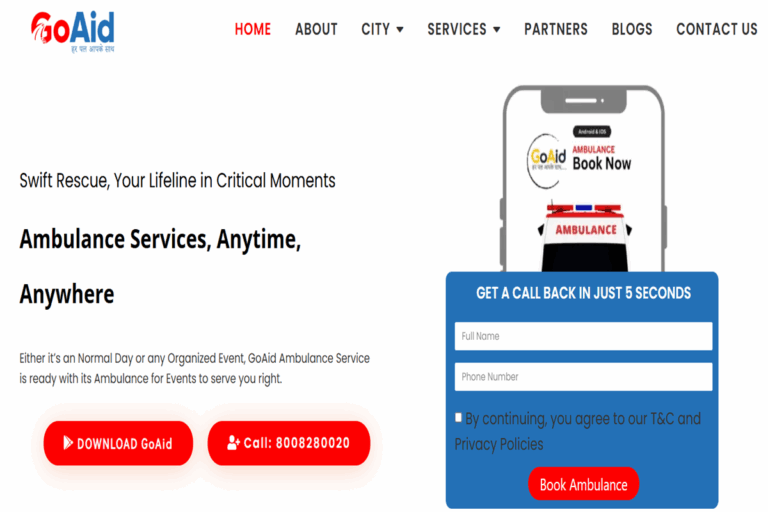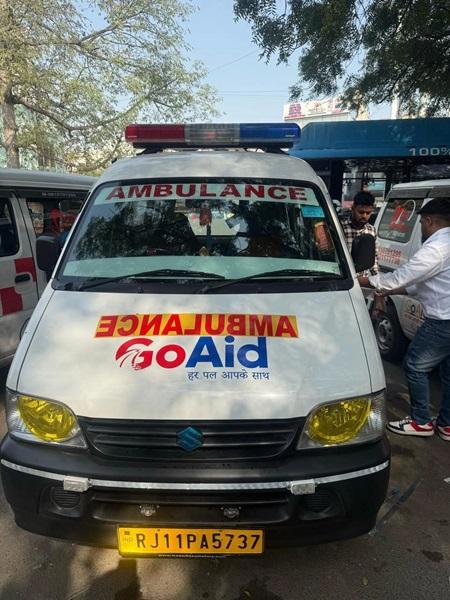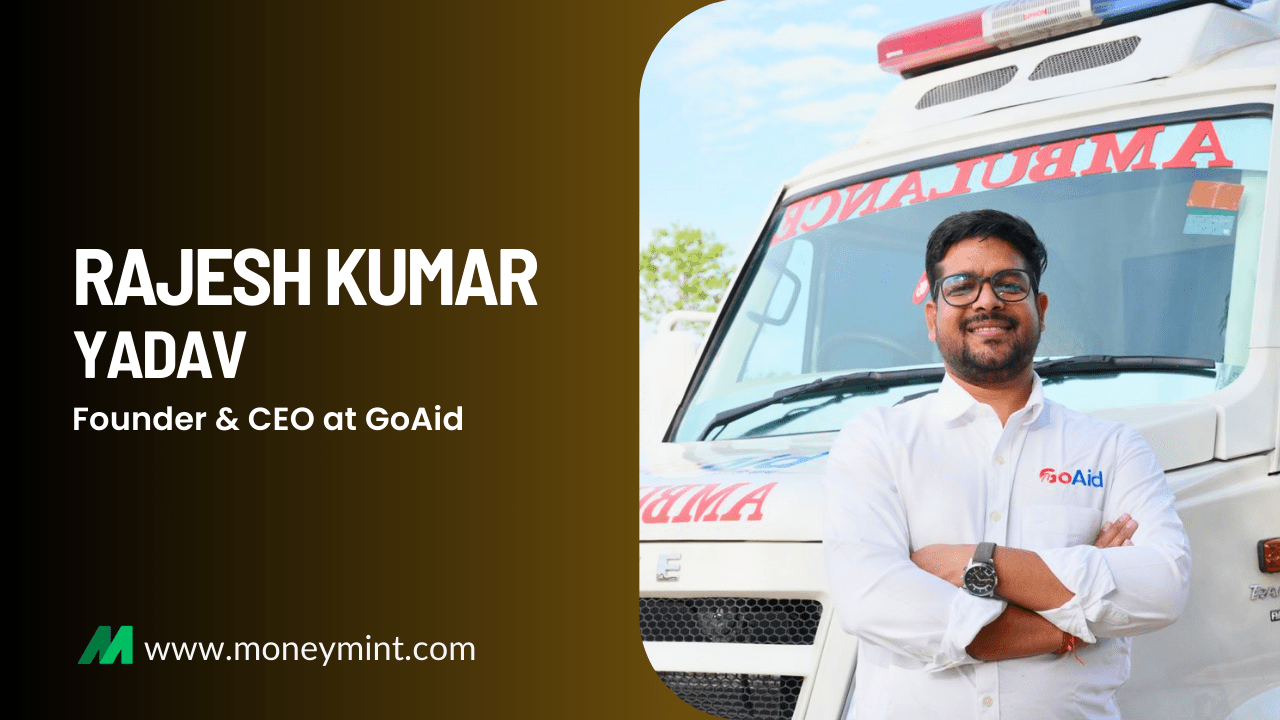If there’s one thing that Indian healthcare has struggled with for years, it’s ambulance response times. Picture this: A critical patient in need of urgent transport, but the ambulance takes 45 minutes to arrive, a delay that could mean the difference between life and death.
For Rajesh Kumar Yadav, this wasn’t just an inconvenience, it was personal. After losing a relative to an ambulance delay, he realized India’s emergency response system was broken. Government helplines (108/102) were slow and unreliable, while private ambulance fleets were fragmented and inconsistent.
So, instead of just complaining about the problem, Rajesh quit his software job and decided to solve it. 💡
The result? GoAid is a 24/7 ambulance aggregation platform that has grown from a tiny fleet of 10 ambulances to a network of 13,800 vehicles across 63 cities without raising a single rupee in VC funding.
Brains Behind GoAid
Kishan Verma, Sanju J, and Rajesh didn’t chase investors, they chased impact. Instead of getting caught up in funding rounds, they focused on building a strong customer base and delivering real results, proving that sustainable growth comes from trust, service, and execution.
Kishan, with his deep tech expertise, ensured GoAid’s platform remained reliable and efficient. Sanju, driven by a passion for social impact, worked tirelessly to expand GoAid’s network and onboard partners. Rajesh, the operations mastermind, streamlined logistics to ensure ambulances arrived faster and served patients better.
Together, they built India’s most trusted ambulance network without external funding, but with an unwavering commitment to saving lives. 🚑🔥
How GoAid Started with Just ₹3 Lakh & Two Second-Hand Ambulances
Before GoAid became a lifesaving force, it was just an idea, and a tough one to execute at that.
- Problem 1: Public Awareness Was Low → Riders still dialed 108 or looked for hospital ambulances instead of using an app.
- Problem 2: Ambulance Owners Were Skeptical → Most owners feared delayed payments or didn’t trust aggregators.
- Problem 3: Regulatory Red Tape → Acquiring state transport permits and biomedical waste licenses was slow and painful.
Instead of waiting for funding, Rajesh and his cofounders pooled ₹3 lakh of personal savings and rented two secondhand ambulances. They then convinced four independent drivers to accept app bookings at a flat per-kilometer price, a pricing model unheard of in a sector that usually charges lump-sum rates.
The first three years were all about hustle and survival.

Flashback: GoAid’s Reality on 1st May 2024
👥 Team Size: 6
💰 Revenue: ₹10L/month
🚑 Monthly Customers: 460
📍 Cities: 3
❌ Investment Raised: ₹0
🙅♂️ Investor Rejections: 3
🏥 Business Partners: 0
By most startup standards, these numbers would scream, “You need funding!” But Rajesh had other ideas.
How GoAid Grew to ₹1CR Monthly Revenue Without External Capital
Instead of chasing investors, GoAid chased customers. Instead of pitching to VCs, they delivered results to partners.
- Signed MOUs with Driver Unions → Expanding coverage from 3 cities to 63 through direct partnerships.
- Built a Viral Pricing Model → The ₹11/km flat fare became a LinkedIn talking point, making GoAid the “Blinkit of ambulances.”
- Leveraged Social Good for Brand Awareness → Free rides for mothers delivering baby girls and seniors discharged from old-age homes brought in 10 M+ organic impressions.
- AI-Powered Dispatching → Rewriting GoAid’s algorithms to autoassign the nearest idle ambulance within 5 seconds, reducing arrival times to 9 minutes 40 seconds in Tier 1 cities.
- Landed Big Business Partners → Securing contracts with Adani, Hitachi, Air India, Indigo, ACC Limited, Maratha Group, and state governments.
- Expanded Internationally → First overseas contract in Dubai to support Indian medical tourists needing ground transport.
The result? By April 2025 → ₹1 Crore in monthly revenue, 3000+ customers per month, and pan-India coverage for B2B services!
GoAid’s Secret Sauce: Obsessing Over Unit Economics
While competitors like Dial 4242, Red. Health and Medulance were raising VC rounds, GoAid stuck to fundamentals:
- Average Ticket Size: ₹2,200
- Take Rate (Commission Cut): 18%
- No Burn Mentality: Bootstrapped, profitable, and zero debt
After three investor rejections, Rajesh stopped pitching altogether, declaring:
“We’ll raise capital only when it fuels growth, not survival.”
What Success Looks Like in May 2025
- 13,800 vetted ambulances, including 2,400 ICU-equipped units.
- 1.3 million cumulative patient transports, with 32% being critical cardiac or stroke cases.
- SLAs are baked into contracts with Adani, Air India, and Indigo for airport medevac duty.
- Hiring 200+ EMTs with a grassroots campaign:
“आओ मिलकर लोगो की ज़िंदगी बचाते हैं” (“Come let’s save lives together”).
GoAid isn’t just growing fastit’s building the foundation for better emergency response across India.
What’s Next for GoAid? The 2025-26 Roadmap

- Launch Subscription Model (₹299/year “GoAid Assure”) → Free 20 km per ride + priority dispatch for members.
- AI Triage Bot on the App → Symptom-based diagnosis to connect users with ambulances in under 30 seconds.
- Tier3 Expansion via Hub and Spoke → Local “GoAid Garages” for oxygen refills & maintenance, reducing deadkilometer costs by 18%.
- Series A Funding (₹4050 Cr) Only After EBITDA > 15% → Raising “growth, not survival” capital remains the founders’ priority.
Takeaways for Other Founders from GoAid’s Success
- Bootstrapping CAN work in operations-heavy health techbut unit economics must come first.
- Building trust is more important than raising adslive GPS tracking, transparent ratings, and no hidden charges helped GoAid grow organically.
- Social impact isn’t just CSRit’s a growth lever. Free Girlchild Rides created 10 M+ impressions and tons of goodwill.
Final Thoughts: GoAid is the Future of Emergency Response
In an industry where delays cost lives, GoAid is proving that smart technology, AI-powered dispatching, and trust-based partnerships can transform emergency healthcare.
They didn’t wait for investors, they didn’t burn moneythey obsessed over customer satisfaction and delivered results. Now, with ₹1CR/month revenue, 13,800 ambulances, and pan-India coverage, GoAid is redefining emergency healthcare, one patient at a time. 🚑✨
Are you ready for the future of emergency response? Because GoAid is already building it. 💡🚀




